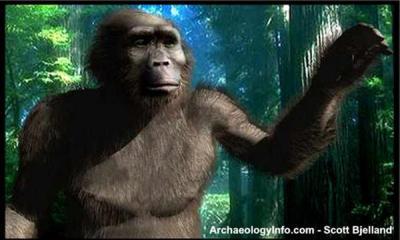Some Paleo Diet believers think neither food nor humanity has evolved but anthropologists disagree. They have found that diets were a 'game changer' in ancient African hominid evolution, even 3.5 million years ago.
Tests on tooth enamel indicate that prior to about 4 million years ago, Africa's hominids were eating essentially chimpanzee style, likely dining on fruits and some leaves, said University of Colorado Boulder anthropology Professor Matt Sponheimer, lead author of the study. Though grasses and sedges were readily available back then, the hominids seem to have ignored them for an extended period.
"We don't know exactly what happened," said Sponheimer. "But we do know that after about 3.5 million years ago, some of these hominids started to eat things that they did not eat before, and it is quite possible that these changes in diet were an important step in becoming human."
New Proceedings of the National Academy of Sciences papers provide detailed information on the teeth of 88 specimens, including five previously unanalyzed hominid species, doubling the dataset. Prior to the new PNAS studies, researchers had analyzed teeth from 87 ancient hominid specimens.
Sponheimer specializes in stable isotope analysis, comparing particular forms of the same chemical element, like carbon, that are present in hominid fossil teeth. The stable carbon isotopes obtained from ancient hominids helps researchers determine what types of plants they were eating, he said.
Carbon signals from hominid teeth are derived from two distinct plant photosynthetic pathways, said Sponheimer: The C3 signals are from plants like trees and bushes, while the C4 signals are from plants like grasses and sedges. The researchers also looked at the microscopic wear of hominid teeth, which provides scientists with more information on the foods they were eating, he said.
While the hominids from the genus Homo that evolved from australopithecines like the 3 million-year-old fossil Lucy -- considered by many the matriarch of modern humans -- were broadening their food choices, a short, upright hominid known as Paranthropus boisei that lived side by side with them in eastern Africa was diverging toward a more specific, C4 diet.
Scientists initially had dubbed P. boisei "Nutcracker Man" because of its large, flat teeth and powerful jaws, but recent analyses indicate it might have instead used its back teeth to grind grasses and sedges, Sponheimer said.

Artistic representation of Paranthropus in southern Africa more than 1 million years ago. Illustration courtesy of ArchaeologyInfo.com/ScottBjelland
"We now have the first direct evidence that as the cheek teeth on hominids got bigger, their consumption of plants like grasses and sedges increased," he said. "We also see niche differentiation between Homo and Paranthropus -- it looks probable that Paranthropus boisei had a relatively restricted diet, while members of the genus Homo were eating a wider variety of things. "The genus Paranthropus went extinct about 1 million years ago, while the genus Homo that includes us obviously did not."
There are some differences in the evolution of hominids in eastern Africa versus southern Africa that still puzzle researchers, said Sponheimer. Paranthropus robustus in southern Africa, for example, was very similar anatomically to its cousin, P. boisei in eastern Africa. But according to the new study, the two had very different carbon isotopic compositions in their teeth and, presumably, diets -- P. robustus seems to have been consuming a substantial amount of C3 vegetation to go along with the C4 grasses or sedges it was eating.
"This has probably been one of the biggest surprises to us so far," said Sponheimer. "We had generally assumed that the Paranthropus species were just variants on the same ecological theme, and that their diets would probably not differ more than those of two closely related monkeys in the same forest.
"But we found that their diets differed as much isotopically as those of forest chimpanzees and savanna baboons, which could indicate their diets were about as different as primate diets can be," he said. "Ancient fossils don't always reveal what we think they will. The upside of this disconnect is that it can teach us a great deal, including the need for caution in making pronouncements about the diets of long-dead critters."
Anthropologists are still pondering what the new data mean in terms of hominid evolution, climate change and changes in the environment, he said. Scientists are particularly interested in the landscapes back then, and whether different geography and/or ecosystems might have impeded or encouraged the dispersal of hominids.
"Isotopes are a great tool for tracking the origin of carbon, but they don't tell the whole story," said Sponheimer. "We would still like to know what specific foods were consumed by the various hominids living several million years ago -- including their mechanical and nutritional properties -- and how such foods might have influenced hominid anatomy over time.
"What we have done to this point is pick the low-hanging fruit, and we've been most successful in determining what various hominids did not eat," said Sponheimer. "But from here on out, we can't expect any easy answers."
Published in the Proceedings of the National Academy of Sciences.





Comments